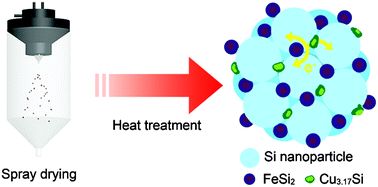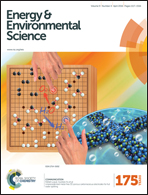Micron-sized Fe–Cu–Si ternary composite anodes for high energy Li-ion batteries†
Abstract
Nano-engineering of silicon anodes has contributed to the demonstration of a promising potential for high energy lithium ion batteries, through addressing the degradation of battery performance derived from severe volume changes during cycling. However, the practical use of nano-engineered silicon anodes is still stuck because of remaining challenges, such as the low tap density, poor scalability and inferior electrical properties. Herein, we successfully developed a new Fe–Cu–Si ternary composite (FeCuSi) by scalable spray drying and facile heat treatment. As a result, FeCuSi exhibited remarkable initial Coulombic efficiency (91%) and specific capacity (1287 mA h g−1). In order to exactly characterize the electrical properties of FeCuSi and directly compare them with industrially developed benchmarking samples such as silicon monoxide (SiO) and a silicon-metal alloy (Si2Fe), both half-cell and full-cell tests were performed with high electrode density (1.6 g cc−1) and high areal capacity (3.4 mA h cm−2). Overall, FeCuSi outperformed the benchmarking samples in terms of discharge capacity and capacity retention in high mass loading for 300 cycles.


 Please wait while we load your content...
Please wait while we load your content...